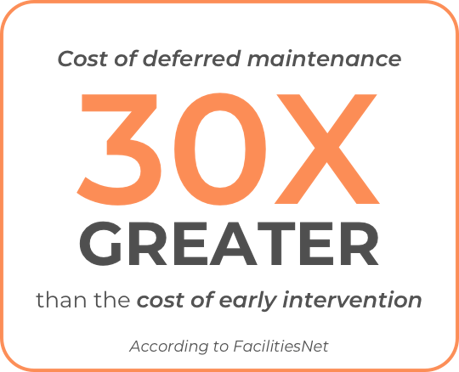
The education sector has a significant problem with deferred maintenance. As institutions face declining revenues due to changes in enrollment and public support, public institutions are experiencing lengthening maintenance backlogs.
These backlogs aren’t only an administrative burden: they create potentially hazardous conditions for the teachers, students, and support staff who frequent education facilities each day. In the US, 35% of higher education facilities were built in the Post-WWII construction boom between 1960 and 1975, and many of these buildings require significant renovations. According to an executive report by EAB, public institutions have seen a 24% increase in their deferred maintenance backlog per square foot from 2007-2015—meaning costs are rising 66% faster than inflation.
The corrections industry has also postponed numerous maintenance tasks due to a lack of funding. About ⅓ of prison facilities in the US are over 50 years old. The Federal Bureau of Prisons reports a backlog of 185 major (projects that cost $300,000 or more) modernization and repair (M&R) projects with an approximate cost of $370 million.
When essential maintenance tasks are put off long enough, organizations pay dearly in the long run. Sometimes, a “repair” becomes a “replacement” as an asset is subjected to continuous usage or wear-and-tear. According to FacilitiesNet, the cost of deferred maintenance can be 30x greater than the cost of early intervention.

What is a maintenance backlog, exactly?
A maintenance backlog consists of work orders that have been approved for scheduling but have not been completed. However, most maintenance backlogs aren’t simply a repository for reactive maintenance tasks or routine inspections—those seemingly insignificant tasks teams put off to fight bigger fires. Backlogs often consist of planned maintenance work—the crucial maintenance tasks that keep the lights on.
For example, the backlog might list daily and weekly corrective repairs, preventive maintenance tasks, predictive maintenance tasks, and jobs planned during periods of scheduled machine downtime.
Note: A backlog can consist of orders that are past due or planned maintenance work that is waiting to be scheduled.
An excessively long maintenance backlog means your technicians are operating in fight-or-flight mode—everything they do is reactive, and planned maintenance is mostly out the window.
Here are some reasons why organizations might build up a backlog over time:
- Deferring maintenance work due to emergencies or lack of funding
- Not having spare parts available to complete the work
- Maintenance technicians with the required skills aren’t available to do the job
- The facility is understaffed
- Poor work order management (someone forgot about the work order or there is no digital trail)
- An outside specialist’s expertise is required for troubleshooting
When many work orders are generated each day, it’s easy for some of them to be missed—especially if you don’t use work order management software or have a maintenance planner. An overreliance on reactive maintenance also creates a backlog. When an emergency occurs, technicians are forced to drop whatever they’re doing to attend to it, which leads to work piling up.
What’s wrong with having a maintenance backlog?

A long list of unclosed work orders or deferred repairs can lead to more expensive problems down the line. A backlog also reduces technicians’ capacity to attend to current maintenance needs, leading to a vicious cycle.
Furthermore, it usually signals a bigger problem such as understaffing, poor work order management, or a lack of inventory control. Maybe you don’t have enough technicians, or technicians don’t have the right information to complete and close out work orders, or they’re spending too much time hunting for parts rather than using a barcode system to find necessary parts and tools.
Here are some potential causes for an extensive maintenance backlog:
- Low technician wrench-on time (the percentage of a technician’s shift spent on actual maintenance work)
- Lack of work order standardization
- Poor inventory control (parts are missing when technicians need them)
- Lack of planned maintenance (preventive maintenance, predictive maintenance, and routine inspections)
- Understaffing
- Overreliance on reactive maintenance forces teams to defer scheduled maintenance
How to shorten your maintenance backlog one step at a time
Even if the situation might seem helpless, especially if your maintenance department is facing a funding shortfall, there are several ways to cut your maintenance backlog. Start by investigating what is causing the backlog— sometimes the problem has nothing to do but with budgets or staffing.
1. Identify what needs to be done
Examine your maintenance backlog. What types of tasks are neglected the most? Which assets are being impacted? A low-risk asset (i.e. equipment not integral to production which is inexpensive/easy to repair or replace) can tolerate longer delays. However, high-risk assets should be tended to immediately.
Organize past due work orders in your CMMS according to asset, type, location, available resources, or other criteria.
Questions to ask:
- How important is each task?
- How frequently is the asset used?
- What is the potential monetary and reputational impact of asset downtime or failure?
Another option is to organize work orders based on the reason they were deferred. For example, some work orders might be missing vital information. Every WO should at least include the name and location of the asset, a description of the problem, the scope of work needed to rectify it, required parts and tools, health and safety information, and a deadline.

Standardize the work order request process to prevent technicians from contacting the original requester to obtain the necessary information. Only accurate and complete work orders should make their way to the schedule. If your maintenance planner or supervisor is approving work orders that are missing vital information, you may need to revisit the WO approval process as well.
If you discover many work orders that weren’t closed due to missing parts, investigate the problem with your inventory management team. Just-in-time inventory management is a form of inventory control that requires working closely with suppliers so that parts and tools arrive shortly before maintenance is due. This is especially important for high-priority planned maintenance tasks—delaying these repairs can be financially ruinous.
Tip: Watch out for duplicate work requests and work requests that are missing vital information. You will need to remove these from the backlog.
2. Schedule past-due tasks alongside new ones
Establish a system for triaging work orders and assigning them alongside ongoing projects. Tasks related to safety should receive high priority, as well as any repairs that might impact production or the functionality of your facility. A high-priority job on a critical asset should take precedence over low-priority work on an auxiliary asset.
If asset usage fluctuates seasonally, take advantage of equipment downtime to perform repairs. Also, review the due dates for each work order.
Maintenance due dates are tricky because they are often meant to be flexible—except for high-priority assets or emergency situations. When a WO is initiated, the due date depends on its relative importance to work that is already in the backlog plus any WOs that may be generated in the future.
Rather than making a subjective assessment of which WOs are critical, you can create a priority index. Assign a criticality number from 1-100 for every piece of equipment (the higher the number, the more critical asset). Next, assign priority to work orders based on the same scale.
Priority Index = Asset Criticality x Work Order Priority
Now, multiply the asset criticality score by the work order priority score. The result is the priority index. Now you can schedule work according to its priority index.
Tip: Have the operations team check and approve your criticality rankings beforehand. Seeing as they use the equipment daily, they may have better insight into which assets are most critical.
3. Determine what resources you need
Now you can move on to planning and scheduling. How many labor hours are needed for each work order? What tools or parts are needed? Are they all referenced in the WO? What parts are not available? Have they been ordered yet? What is their delivery status? CMMS calendars help with maintenance planning and scheduling upcoming tasks. Use your CMMS to assign WOs to team members and determine if you need to outsource any tasks.
Remember, if you need to outsource work or increase staffing costs temporarily, don’t hesitate to do so if it means you can permanently erase your backlog.
4. Review and revise your plan
Pick a time to evaluate how your plan to reduce your backlog is going. Are you creating even more of a backlog as new WOs come in but technicians are busy dealing with past due work orders? If so, you might need to increase headcount or outsource tasks. Use your CMMS to identify open WOs and update schedules.
 For immediate assistance, please call us at (512) 328-3235
For immediate assistance, please call us at (512) 328-3235



